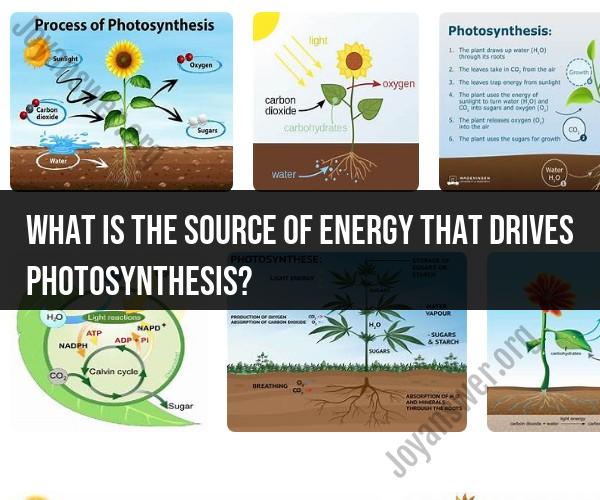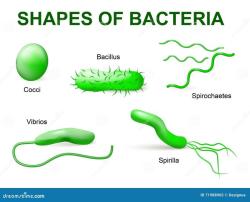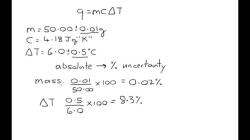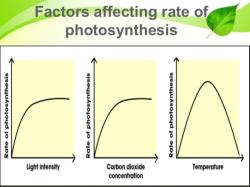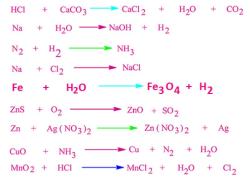What is the source of energy that drives photosynthesis?
The source of energy that drives photosynthesis is sunlight. Photosynthesis is a complex biochemical process that occurs in the chloroplasts of plant cells (and in some types of bacteria), and it involves the conversion of light energy into chemical energy stored in glucose and other organic molecules.
Here's a simplified overview of the process:
Absorption of Light: Chlorophyll and other pigments in the chloroplasts of plant cells absorb sunlight. Chlorophyll is particularly efficient at capturing light energy.
Conversion of Light Energy: The absorbed light energy is used to power a series of chemical reactions that take place in the chloroplasts. These reactions are collectively known as the "light-dependent reactions."
Water Splitting: During the light-dependent reactions, water molecules (H2O) are split into oxygen (O2), protons (H+ ions), and electrons (e-). This process is called photolysis.
Production of ATP and NADPH: The energy from the absorbed sunlight is used to generate two important molecules: adenosine triphosphate (ATP) and nicotinamide adenine dinucleotide phosphate (NADPH). These molecules store the energy in a form that can be used in the next stage of photosynthesis.
Calvin Cycle (Light-Independent Reactions): In the second stage of photosynthesis, known as the Calvin Cycle (or dark reactions), ATP and NADPH produced in the light-dependent reactions are used to convert carbon dioxide (CO2) into glucose and other carbohydrates. This process stores the energy from sunlight in chemical bonds.
Overall, sunlight is the primary source of energy that powers the conversion of carbon dioxide and water into glucose and oxygen in photosynthesis. Plants and other photosynthetic organisms are essentially nature's "solar-powered" factories, capturing and storing the energy from the sun in the form of carbohydrates, which serve as the basis for the food chain and provide energy for all living organisms on Earth.
Photosynthesis Power: Exploring the Energy Source
Photosynthesis is the process by which plants and algae use sunlight, water, and carbon dioxide to produce oxygen and energy in the form of sugar. This process is essential for life on Earth, as it provides the oxygen that we breathe and the food that we eat.
The energy for photosynthesis comes from sunlight. Plants contain a green pigment called chlorophyll, which absorbs sunlight and uses its energy to split water molecules into hydrogen and oxygen. The hydrogen atoms are then used to reduce carbon dioxide to sugar. The oxygen atoms are released into the atmosphere.
Photosynthesis is a very efficient process. About 10-20% of the sunlight that strikes a plant leaf is converted into chemical energy. This energy is then used by the plant to grow and reproduce.
Sunlight's Role in Photosynthesis: The Ultimate Energy Source
Sunlight is the ultimate energy source for photosynthesis. It provides the energy that plants need to split water molecules and reduce carbon dioxide to sugar.
Sunlight is a renewable energy source, which means that it can be replenished naturally. This makes it a sustainable source of energy for photosynthesis.
Photosynthesis is a very important process for life on Earth. It provides the oxygen that we breathe and the food that we eat. It also helps to regulate the climate by removing carbon dioxide from the atmosphere.
Unraveling Photosynthesis: The Source of Its Energy
The energy for photosynthesis comes from sunlight. Sunlight is a form of electromagnetic radiation, which is made up of photons. Photons are packets of energy that can be absorbed by matter.
When a photon strikes a chlorophyll molecule, it excites an electron in the chlorophyll molecule. This excited electron can then be used to split water molecules and reduce carbon dioxide to sugar.
The process of photosynthesis is divided into two stages: the light-dependent reactions and the Calvin cycle.
The light-dependent reactions use the energy from sunlight to split water molecules and produce NADPH and ATP. NADPH and ATP are energy-rich molecules that are used in the Calvin cycle to reduce carbon dioxide to sugar.
The Calvin cycle does not require light. It uses the energy from NADPH and ATP to reduce carbon dioxide to sugar.
The products of photosynthesis are sugar and oxygen. Sugar is used by the plant for energy and to grow. Oxygen is released into the atmosphere.
Photosynthesis is a very complex process, but it is essential for life on Earth. It provides the oxygen that we breathe and the food that we eat. It also helps to regulate the climate by removing carbon dioxide from the atmosphere.
